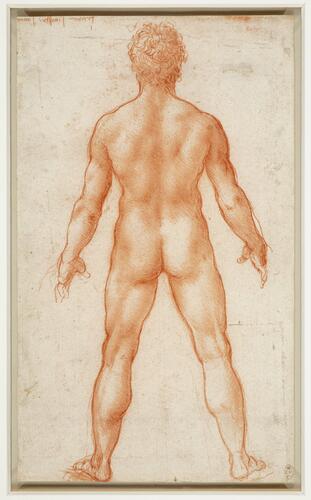-
1 of 253523 objects
A standing male nude c.1504-6
Red chalk | 27.0 x 16.0 cm (sheet of paper) | RCIN 912596

Leonardo da Vinci (1452-1519)
912596 V.jpg c.1504-6


-
A study of a nude man standing with his legs apart, seen from behind.
In 1503 Leonardo began preparations for the huge mural of the Battle of Anghiari, to be painted in the council chamber of the Palazzo della Signoria in Florence. His preparatory drawings for the composition, of men and horses in violent action, led Leonardo back to a prolonged study of anatomy and proportion. Leonardo made a number of drawings of male nudes standing, seen directly from in front or behind, and of legs from all angles with the muscles strongly emphasised. These nude studies were not directly preparatory for the Battle, but 'background research' on the human form, almost in the manner of a systematic survey of the body, in the manner of a series of architectural elevations.
Here the model spreads his legs equally to balance his weight distribution, and in other drawings from the same series he supported his arms by holding sticks so as to put no strain on the shoulder muscles: while it was important for expressive purposes to know how to draw the muscles in tension, it was just as important to know how to draw them when relaxed.
In some of his drawings the divisions between the muscles are so sharp that Leonardo must have intended to represent an ecorché, or flayed body; though there is no firm evidence that he performed human dissection until around 1507-08, he may have worked on corpses in the monastery hospitals at an earlier date. Though the shading of the body here is very subtle, almost every superficially visible muscle mass is clearly depicted. In the back, one can discern the muscles trapezius, latissimus dorsi and erector spinae; the inferior angle of the right scapula is emphasised, and in the arm, triceps is prominent. In the buttocks, gluteus maximus is well modelled, as are the ‘hamstring’ muscles of the thigh. Below the popliteal fossa (the ‘knee pit’) are the well-developed muscles of the calf, gastrocnemius and soleus, and the elongated-hourglass form of the Achilles or calcaneal tendon is accurately shown.
There was no attempt here, as there was in the earlier anatomical drawings, to impose a system of proportion on the figure, or to derive such a system from measurements taken from the model. Instead Leonardo concentrated on capturing the subtleties of surface modelling, drawn rapidly with lightly hatched chalk, and of contour - the foreshortening of the hands, in particular, is masterful. The outlines were drawn repeatedly with light passes of the chalk, giving a vibrancy that transforms the image from a static illustration into a study of a living, breathing individual. That individual may be identified by the cut inscription at top left, franc sinisstre sonat[...], as a musician (sonatore) named Francesco Sinistre (though this is not a likely surname). Leonardo occasionally annotated his studies of horses with the breed and owner, but this is the only such inscription on a human figure study.Provenance
Bequeathed to Francesco Melzi; from whose heirs purchased by Pompeo Leoni, c.1582-90; Thomas Howard, 14th Earl of Arundel, by 1630; probably acquired by Charles II; Royal Collection by 1690
-
Creator(s)
Acquirer(s)
-
Medium and techniques
Red chalk
Measurements
27.0 x 16.0 cm (sheet of paper)
Object type(s)
Other number(s)